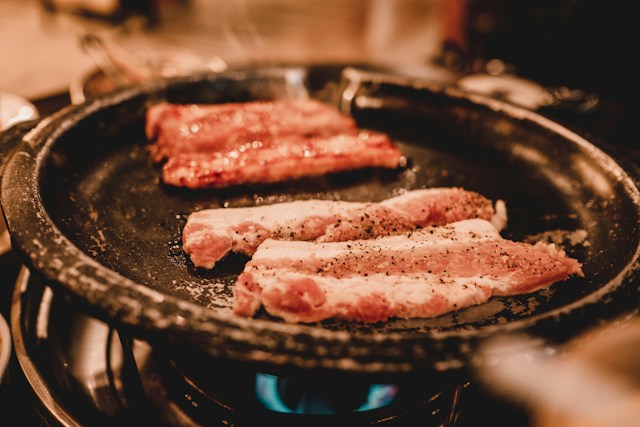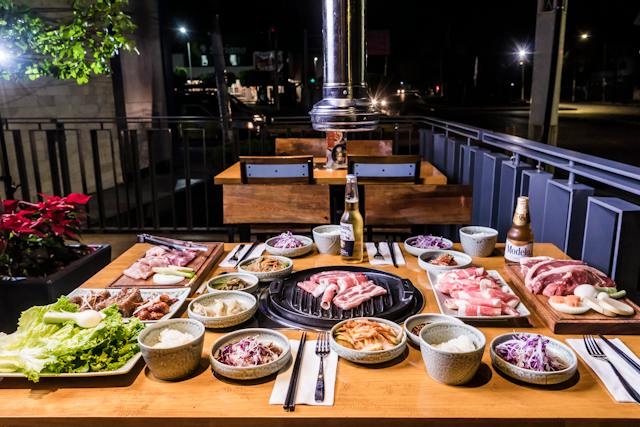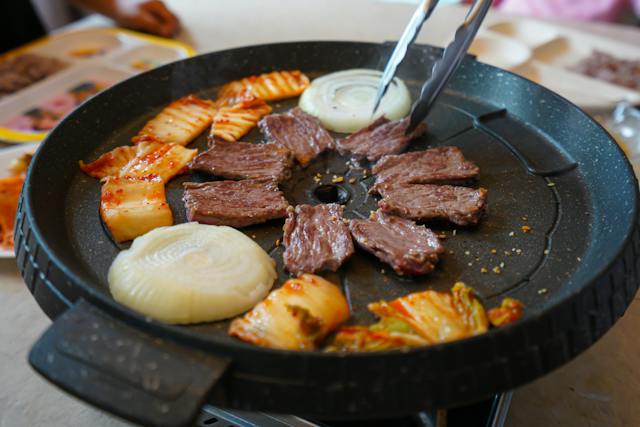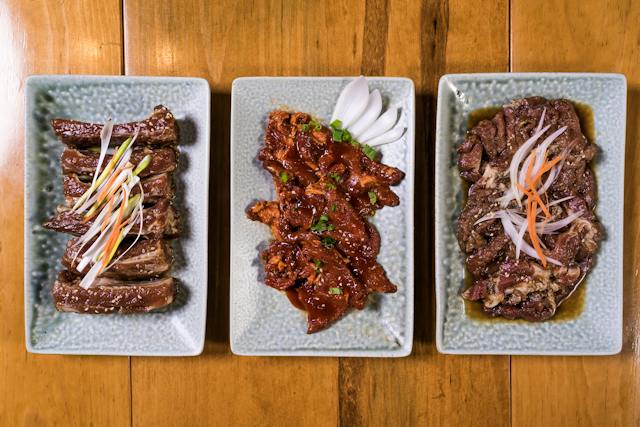Korean barbecue has a rich history dating back to ancient times. The tradition of grilling meat on open flames can be traced to the Goguryeo era (37 BCE – 668 CE), where communities engaged in communal meat grilling as a form of celebration. In this blog post, we will discuss what is Korean Barbecue (Korean BBQ) including the origins and history of Korean barbeque.
1. History of Korean Barbecue
Historical interactions with Mongolian and Chinese cultures played a pivotal role in shaping Korean barbecue. The method of grilling thin slices of meat directly at the table, a characteristic of Korean barbecue, draws inspiration from Mongolian and Chinese culinary practices. Then over the centuries, Korean barbecue has evolved, incorporating various cooking styles and flavors. The introduction of marinated meats, diverse side dishes, and distinct grilling techniques contributed to the development of the unique and dynamic dining experience known today.
Social and Cultural Significance
Korean barbecue is more than just a meal; it is a social and cultural event. Rooted in the Confucian tradition of communal dining, it emphasizes sharing, bonding, and the importance of relationships. The act of cooking together at the table fosters a sense of unity and connection.
Variety of Meats and Distinctive Marinades and Sauces
Korean barbecue offers a diverse selection of meats, including beef, pork, chicken, and even lamb. Different cuts, from thinly sliced bulgogi to marbled pork belly (samgyeopsal), provide a wide range of flavors and textures. Marinades and sauces are integral to Korean barbecue. Gochujang (fermented red chili paste), soy-based marinades, and savory dipping sauces contribute to the bold and flavorful profile that defines Korean barbecue.
In recent years, Korean barbecue has undergone innovations and modernization. The introduction of barbecue buffets, high-quality meats, and creative fusion dishes has elevated the dining experience, making it a global culinary sensation.
Excitement of Recreating the Experience at Home
Recreating the Korean barbecue experience at home allows enthusiasts to capture the essence of a restaurant setting. Setting up a tabletop grill, selecting premium cuts of meat, and arranging banchan (side dishes) on the table replicates the vibrant atmosphere of a Korean barbecue establishment. The beauty of preparing Korean barbecue at home lies in the ability to tailor the experience to personal preferences. From choosing favorite cuts of meat to adjusting marinade flavors, home cooks have the creative freedom to customize every aspect of the meal.
Cooking Korean barbecue at home becomes a shared experience, bringing family and friends together. The collaborative effort of grilling meats, preparing side dishes, and setting the table fosters a sense of togetherness and joy. Recreating Korean barbecue at home provides an opportunity to explore authentic recipes. Learning the art of making marinades, discovering traditional banchan recipes, and understanding the nuances of grilling techniques contribute to a deeper appreciation of Korean culinary traditions.
Creating a Personalized Atmosphere
Beyond the flavors, the home environment can be personalized to enhance the overall experience. Playing traditional Korean music, setting a cozy dining area, and incorporating Korean tableware contribute to an immersive and enjoyable dining atmosphere. Home cooks can experiment with culinary creativity by adding unique twists to traditional Korean barbecue. Infusing local ingredients, trying out fusion flavors, or introducing new side dishes contribute to an exciting and personalized dining adventure.
Establishing Food Memories
Recreating Korean barbecue at home becomes an opportunity to establish lasting food memories. Whether celebrating special occasions or enjoying casual gatherings, the experience of cooking and sharing Korean barbecue becomes a cherished part of one’s culinary journey.
The history and significance of Korean barbecue showcase its deep cultural roots and communal nature. Recreating this experience at home brings joy, connection, and the freedom to explore the rich tapestry of Korean culinary traditions in a personalized and meaningful way.
2. Origins of Korean Barbecue
Goguryeo Era (37 BCE – 668 CE)
Communal Celebrations
The roots of Korean barbecue extend back to the Goguryeo era, an ancient kingdom on the Korean Peninsula. During this period, communal celebrations often involved the ritualistic act of grilling meat over open flames. This practice served as a symbol of unity, festivity, and shared joy within the community.
Primitive Grilling Techniques
In the absence of modern grilling equipment, the early forms of Korean barbecue involved rudimentary grilling techniques. Meat was likely skewered or placed directly on open flames, showcasing the resourcefulness of ancient communities in savoring the flavors of grilled meats.
Evolution of Gogigui
Culinary Adaptations
As Korean society progressed, so did the culinary practices surrounding meat preparation. The concept of “Gogigui” evolved beyond simple communal grilling, incorporating a variety of cuts, marinades, and cooking methods that laid the foundation for the diverse world of Korean barbecue we know today.
Influences from Neighboring Cultures
The Korean Peninsula’s geographic proximity to China and Mongolia played a significant role in shaping the evolution of Gogigui. Influences from neighboring cultures introduced new grilling techniques and culinary styles, contributing to the unique fusion that characterizes Korean barbecue.
Confucian Traditions
Confucianism and Communal Dining
The Confucian traditions that gained prominence during later Korean dynasties further embedded the communal aspect of dining. Shared meals, where individuals gathered around a common table, became a central tenet of Confucian values, influencing the communal nature of Korean barbecue.
Symbolism of Unity
Grilling and sharing meat during communal gatherings took on a symbolic meaning, representing unity, familial bonds, and the importance of shared experiences. The act of preparing and enjoying food together became a reflection of social harmony and mutual respect.
Rituals and Celebrations
Festive Occasions
Korean barbecue became intricately tied to festive occasions, marking celebrations, feasts, and significant milestones. The tradition of grilling meat became a cultural ritual, transforming ordinary meals into joyful experiences that strengthened social bonds.
Gogigui in Ceremonial Practices
Beyond everyday dining, Gogigui found a place in ceremonial practices. Offerings of grilled meat in ancestral rituals and celebratory events connected the act of grilling to spiritual and cultural dimensions, emphasizing its enduring significance in Korean culture.
Legacy and Global Impact
Spread of Korean Barbecue Globally
As Korea’s cultural influence expanded globally, so did the popularity of Korean barbecue. The rich legacy of Gogigui, with its deep historical roots and communal spirit, became a culinary ambassador, captivating the taste buds of people around the world.
Modern Adaptations and Innovations
While staying true to its historical roots, Korean barbecue continues to evolve. Modern adaptations, innovative grilling techniques, and a diverse array of meats and marinades showcase the resilience and dynamism of Gogigui in the contemporary culinary landscape.
The origins of Korean barbecue trace back to the ancient Goguryeo era, where communal meat grilling served as a cultural and celebratory practice. This tradition, shaped by Confucian values and influenced by neighboring cultures, has evolved into a globally cherished culinary phenomenon, embodying the rich history and shared joy of communal dining in Korean culture.
3. Evolution Over Centuries
Culinary Transformations
Early Grilling Techniques
The primitive grilling techniques of ancient times gradually transformed over the centuries. What began as communal grilling in the Goguryeo era evolved into a sophisticated culinary art form with innovations that enhanced flavors and cooking methods.
Introduction of Marinades
One significant evolution in Korean barbecue was the introduction of marinades. Early methods of grilling primarily focused on the natural flavors of meat. However, as culinary techniques advanced, Koreans began marinating meats in flavorful blends of soy sauce, sesame oil, garlic, and other seasonings, creating iconic dishes like bulgogi.
Diverse Array of Meats
Expansion Beyond Beef
While beef remains a staple in Korean barbecue, the evolution expanded the variety of meats used. Pork, chicken, and even lamb found their way onto barbecue grills, each bringing its unique texture and taste. This diversification broadened the appeal of Korean barbecue.
Marbling and Quality
With a focus on enhancing the dining experience, attention shifted towards the quality of meat. Marbled cuts, known for their tenderness and rich flavor, became sought after. This emphasis on quality contributed to the premium experience associated with modern Korean barbecue.
Development of Distinct Grilling Techniques
Tabletop Grilling Culture
One of the most defining features of Korean barbecue is the tabletop grilling experience. The transition from communal grilling in communal spaces to grilling directly at the dining table added an interactive and social element to the culinary tradition.
Specialized Grilling Equipment
Advancements in technology led to the development of specialized grilling equipment, such as built-in exhaust systems and adjustable grates. These innovations improved the overall grilling experience, allowing for precise control of heat and ventilation.
Emergence of Banchan
Side Dishes and Complementary Flavors
The evolution of Korean barbecue brought about the tradition of serving an array of banchan, or side dishes, alongside grilled meats. Banchan includes a variety of pickled vegetables, kimchi, and savory pancakes, enhancing the overall dining experience with a spectrum of complementary flavors.
Balance of Flavors
The inclusion of banchan contributes to a balanced meal, with the tanginess of pickled vegetables cutting through the richness of grilled meats. This balance not only elevates the taste but also reflects the intricate and thoughtful approach to Korean cuisine.
Fusion of Tradition and Modernity
Global Influence and Fusion Dishes
As Korean culture gained global popularity, Korean barbecue embraced international influences. Fusion dishes, blending traditional Korean flavors with global ingredients and cooking styles, became a part of the evolving narrative, showcasing the adaptability and creativity within Korean culinary traditions.
Interactive Dining Experience
The evolution of Korean barbecue transformed it into more than just a meal; it became an interactive dining experience. The communal aspect of grilling at the table fosters conversation, laughter, and a sense of shared enjoyment, embodying the spirit of Korean hospitality.
Culinary Tourism and Cultural Impact
Global Culinary Phenomenon
Korean barbecue’s evolution has positioned it as a global culinary phenomenon. Culinary tourism thrives as people from around the world seek the authentic experience of grilling meats at Korean barbecue establishments, further solidifying its cultural impact.
Cultural Icon and Ambassador
Korean barbecue has become a cultural icon and ambassador, representing the dynamic and rich culinary heritage of Korea. Its evolution over centuries reflects the adaptability of Korean cuisine, making it an integral part of global gastronomy.
The evolution of Korean barbecue over centuries showcases a culinary journey marked by innovation, diversification, and a commitment to delivering a memorable dining experience. From the introduction of marinades to the diverse array of meats and the interactive grilling culture, Korean barbecue has evolved into a global culinary phenomenon while preserving its cultural roots.
4. Social and Cultural Significance
Confucian Traditions and Communal Dining
Influence of Confucianism
The social and cultural significance of Korean barbecue is deeply rooted in Confucian traditions. Confucianism emphasizes the importance of family, respect for elders, and communal harmony. Korean barbecue aligns with these values, providing a platform for families and friends to come together.
Communal Dining as a Virtue
Within Confucianism, communal dining is considered a virtue. The act of sharing a meal signifies equality, unity, and mutual respect. Korean barbecue, with its emphasis on shared grilling and communal enjoyment, embodies these Confucian ideals.
Celebration of Relationships
Family Bonding
Korean barbecue is a celebration of relationships, particularly within the family. Families gather around the table, participating in the shared experience of grilling meats, enjoying banchan, and creating lasting memories. This communal aspect strengthens familial bonds.
Friendship and Camaraderie
Beyond familial relationships, Korean barbecue is a social event that fosters friendship and camaraderie. Whether with close friends or acquaintances, the act of grilling and dining together facilitates conversations, laughter, and the building of connections.
Symbol of Unity and Connection
Shared Experience at the Table
The act of cooking together at the table is more than a culinary experience; it is a shared journey. As individuals take turns grilling meats, pass around banchan, and collectively savor the meal, a sense of unity and connection is forged, transcending the boundaries of everyday life.
Breaking Down Barriers
Korean barbecue has a unique way of breaking down social barriers. The informal setting, where everyone actively participates in the meal preparation, creates an environment where people feel at ease, encouraging openness and genuine interactions.
Generational Harmony
Respect for Elders
The Confucian principles of filial piety and respect for elders are reflected in the dynamics of Korean barbecue. Younger individuals often take on the role of grilling meats for their elders, demonstrating a symbolic act of respect and care.
Cross-Generational Connections
The intergenerational nature of Korean barbecue promotes cross-generational connections. Elders share stories and wisdom, while younger family members contribute to the cooking process. This exchange fosters a harmonious atmosphere, where generations come together in mutual appreciation.
Communal Festivities and Celebrations
Special Occasions
Korean barbecue is often associated with special occasions and celebrations. Birthdays, holidays, and milestones are marked with communal feasts around the barbecue grill. This tradition turns ordinary meals into festive events, elevating the significance of shared experiences.
Cultural Rituals
The communal nature of Korean barbecue extends to cultural rituals. Offering grilled meats in ancestral ceremonies and celebrating cultural festivals around the barbecue table reinforce the cultural identity and traditions passed down through generations.
Modern Expressions of Tradition
Continuity of Tradition
Korean barbecue represents the continuity of tradition in a modern context. While rooted in Confucian values, it has adapted to contemporary lifestyles, becoming a cultural expression that resonates with both locals and global enthusiasts.
Global Appeal
The social and cultural significance of Korean barbecue has transcended borders, making it a global culinary sensation. Its appeal lies not only in the delectable flavors but also in the shared experiences and connections it fosters, making it a symbol of Korean hospitality and culture worldwide.
Korean barbecue’s social and cultural significance goes beyond the act of eating; it encapsulates the essence of shared moments, unity, and cultural values. Rooted in Confucian traditions, this culinary tradition continues to be a cherished part of Korean culture, symbolizing the importance of relationships and the joy found in communal dining. To learn more about Korean culture and food, check out my previous posts.



